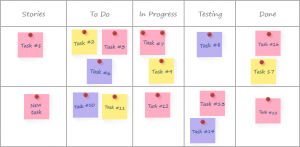There’s an old Chinese proverb: “May you live in interesting times.” This certainly applies to 2021. Not only are these interesting times but some of the most unstable we’ve ever seen.
Companies globally are struggling to adapt to remote working, and employee morale and productivity have been lowered as a result. It’s not exactly surprising – it’s hard to keep your chin up when you feel so disconnected from the rest of your colleagues. Upskilling is therefore more important than ever.
But what is upskilling? At its core, upskilling is when an employee learns additional skills that help them in their role. This can include learning to use new software or analytics or even gaining organizational transformation skills.
This article will give you six handy tips to upskill your newly remote workforce.
1. Create Personal Development Plans (PDPs)
PDPs, or personal development plans, are a personalized report that tracks how an individual employee is doing in your company. They answer questions such as:
- What is their role?
- How are they performing in it?
- What could they do to improve?
- How could they do this?
- What help are you giving them to achieve this goal?
In a practical sense, PDPs and their utility largely depend on the size of your company and how much of it is automated. We could go on and on about the AI vs IA debate, but the bottom line is this: what percentage of your company is run by people?
Specifically, think about the number of employees you’ve got. If you’re running a small business, the benefits of creating PDPs far outweigh the effort required. However, trying to write individual PDPs for thousands of employees isn’t feasible.
As an alternative, consider creating PDPs by department or sector. This has the same effect of encouraging company unity but without the hassle of sitting down and writing a million personalized plans.
At the end of the day, you’ve got to prioritize which new skills your employees need to learn that will enable them to take their role to the next level.

2. Introduce Job Aids
Now you’ve established your PDPs, you need to create resources that aid your employees in learning these new skills. These will be specific to your business, but here are some general tips for developing them:
- Each aid should be no longer than one page.
- They should be accessible. Consider adding a real-time transcription feature for employees who are sight or motor-impaired, for example. Use dyslexia-friendly fonts and avoid clashing colors.
- You should make each step completely clear. Perhaps use a “dos and don’ts” format to set out exactly what your employees should and shouldn’t be doing.
- You should set out all information in palatable, ‘bite-sized’ chunks.
Above all, make your aids friendly and colloquial. Remember, the aim is not to punish your staff for not doing things right or having failed to adapt to the new normal. You’re trying to encourage them to learn new things, not reprimand them.
3. Assign Mentors
If the job aids don’t do the trick or you want to provide a little extra push, you can assign each employee or group of employees a remote mentor to help them achieve their development goals.
This step can help to ensure business continuity, which is essentially the practice of being prepared for large changes in one’s business. There are a few different types of business continuity planning software out there that you can use alongside your mentoring program.
The idea behind business continuity planning is this: if something big should happen in the world of business, such as a recession, economic crash, or something physical like a natural disaster, your employees will be able to adapt to whatever situation comes their way.
With appropriate software and equipment and a mentor to teach them how to use it, your workers will feel much better prepared for any new challenges that remote working might bring.
Other benefits to mentoring include:
- Employees getting the opportunity to gain experience and network
- Increased morale and happiness at work
- Improved collaboration between management and lower-level employees, giving the former access to fresh insights and perspectives

4. Provide Incentives
Let’s face it: this pandemic has been pretty depressing for everybody. Morale is understandably at an all-time low, so it might be your employees aren’t interested in upskilling at all. Who can blame them?
Thankfully, there are a few things you can do that will cheer everyone up and get them excited about the chance to develop their skills. Consider implementing a few of these suggestions:
- Give out rewards for things like most new skills learned or the completion of a new skill training course. Offer items such as vouchers, gift cards, or even cash prizes.
- Make sure to compliment and encourage your staff regularly regarding the new skills they’ve gained. Be a good leader.
- Offer access to a ‘personal cell phone use for work’ scheme. This will allow employees to practice their skills on a device they’re familiar with. Give them some form of recompense for this – after all, they’re using personal equipment to get the job done.
- Offer bonuses and/or agree to more flexible hours. The pandemic has been mentally taxing for everyone, not to mention financially draining. If you cut your staff some slack, they’ll have more time (and energy) to focus on upskilling.
5. Maintain Communication
This is a crucial step. If you don’t communicate properly, nobody will know what they’re doing and the company will fall into chaos. Luckily, communicating on a large scale is relatively easy these days, especially in this new age of remote working.
If you have a small company with few employees, send out bulk emails or hold daily stand-up meetings to keep everyone in the loop. If you run a larger company, with many employees based in a range of locations, consider implementing a phone tree service so staff can reach the right department in minutes. The idea is to make upskilling easy and learning accessible.
It’s all about knowing your people and what they need. Once you’ve got that sorted, figuring out how to communicate with them is simple. Increasing inter-department communication will also help in your upskilling endeavor as employees can learn from each other.

6. Company Culture
This one is fairly straightforward and has nothing to do with fancy strategies or technology. All the business continuity planning or agile testing methodology schemes in the world won’t help if your remote employees can’t upskill fast enough to adapt.
To help with this, create a strong company culture based on core values that are stuck to at all times. These might include:
- Creating a supportive remote environment for learning new skills
- Encouraging collaboration
- Fostering transparency
- Providing development opportunities online
- Practicing accessible leadership
If your company has these values at its core, upskilling your remote workforce will be a heck of a lot easier.
Isn’t it time you put these tips to work in your business?
Business & Finance Articles on Business 2 Community
(56)






